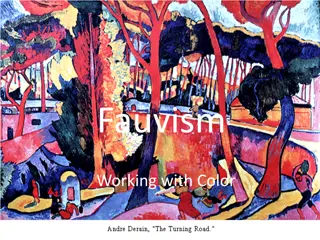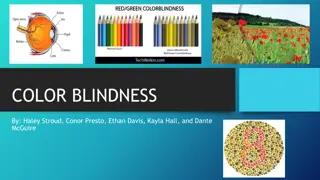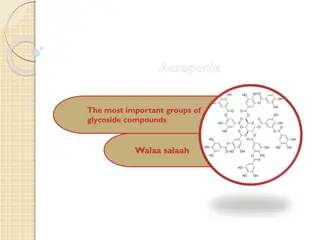Crystal Field Theory and Color Exhibited by Coordination Compounds
Crystal Field Theory (CFT) explains the colors exhibited by coordination compounds based on the absorption of light and electron transitions in d-orbitals. The theory describes how ligands interact with transition metal ions, causing the d-orbitals to split in energy levels. This split results in the absorption of specific wavelengths of light, leading to the observation of bright colors in coordination complexes. CFT, developed in the 1930s, sheds light on magnetic properties, colors, and structures of transition metal complexes, providing insight into chemical bonding processes.
Download Presentation

Please find below an Image/Link to download the presentation.
The content on the website is provided AS IS for your information and personal use only. It may not be sold, licensed, or shared on other websites without obtaining consent from the author.If you encounter any issues during the download, it is possible that the publisher has removed the file from their server.
You are allowed to download the files provided on this website for personal or commercial use, subject to the condition that they are used lawfully. All files are the property of their respective owners.
The content on the website is provided AS IS for your information and personal use only. It may not be sold, licensed, or shared on other websites without obtaining consent from the author.
E N D
Presentation Transcript
Which colours are exhibited? colour wheel This colour wheel demonstrates which colour a compound will appear if it only has one absorption in the visible spectrum. For example, if the compound absorbs red light, it will appear green. absorbed versus colour observed 400 nm Violet absorbed, Green-yellow observed ( 560 nm) 450 nm Blue absorbed, Yellow observed ( 600 nm) 490 nm Blue-green absorbed, Red observed ( 620 nm) 570 nm Yellow-green absorbed, Violet observed ( 410 nm) 580 nm Yellow absorbed, Dark blue observed ( 430 nm) 600 nm Orange absorbed, Blue observed ( 450 nm) 650 nm Red absorbed, Green observed ( 520 nm) http://upload.wikimedia.org/wikipedia/en/thumb/1/1e/Colrowheel.jpg/150px-Colrowheel.jpg
The bright colours exhibited by many coordination compounds can be explained by Crystal Field Theory. If the d-orbitals of such a complex have been split into two sets as described above, when the molecule absorbs a photon of visible light one or more electrons may momentarily jump from the lower energy d- orbitals to the higher energy ones to transiently create an excited state atom. The difference in energy between the atom in the ground state and in the excited state is equal to the energy of the absorbed photon, and related inversely to the wavelength of the light. Because only certain wavelengths ( ) of light are absorbed - those matching exactly the energy difference - the compounds appears the appropriate complementary colour. As explained above, because different ligands generate crystal fields of different strengths, different colours can be seen. For a given metal ion, weaker field ligands create a complex with a smaller , which will absorb light of longer and thus lower frequency . Conversely, stronger field ligands create a larger , absorb light of shorter , and thus higher . It is, though, rarely the case that the energy of the photon absorbed corresponds exactly to the size of the gap ; there are other things (such as electron-electron repulsion and Jahn-Teller effects) that also affect the energy difference between the ground and excited states.
Crystal field theory (CFT) is a model that describes the electronic structure of transition metal compounds, all of which can be considered coordination complexes. CFT successfully accounts for some magnetic properties, colours, hydration enthalpies, and spinel structures of transition metal complexes, but it does not attempt to describe bonding. CFT was developed by physicists Hans Bethe and John Hasbrouck van Vleck[1] in the 1930s. CFT was subsequently combined with molecular orbital theory to form the more realistic and complex ligand field theory (LFT), which delivers insight into the process of chemical bonding in transition metal complexes.
According to CFT, the interaction between a transition metal and ligands arises from the attraction between the positively charged metal cation and negative charge on the non-bonding electrons of the ligand. The theory is developed by considering energy changes of the five degenerate d-orbitals upon being surrounded by an array of point charges consisting of the ligands. As a ligand approaches the metal ion, the electrons from the ligand will be closer to some of the d-orbitals and farther away from others causing a loss of degeneracy. The electrons in the d-orbitals and those in the ligand repel each other due to repulsion between like charges. Thus the d-electrons closer to the ligands will have a higher energy than those further away which results in the d-orbitals splitting in energy. This splitting is affected by the following factors: the nature of the metal ion. the metal's oxidation state. A higher oxidation state leads to a larger splitting. the arrangement of the ligands around the metal ion. the nature of the ligands surrounding the metal ion. The stronger the effect of the ligands then the greater the difference between the high and low energy 3d groups.
The most common type of complex is octahedral; here six ligands form an octahedron around the metal ion. In octahedral symmetry the d-orbitals split into two sets with an energy difference, oct where the dxy, dxz and dyz orbitals will be lower in energy than the dz2 and dx2-y2, which will have higher energy, because the former group are farther from the ligands than the latter and therefore experience less repulsion. Tetrahedral complexes are the second most common type; here four ligands form a tetrahedron around the metal ion. In a tetrahedral crystal field splitting the d-orbitals again split into two groups, with an energy difference of tet where the lower energy orbitals will be dz2 and dx2-y2, and the higher energy orbitals will be dxy, dxz and dyz - the opposite way round to the octahedral case. Furthermore, since the ligand electrons in tetrahedral symmetry are not oriented directly towards the d-orbitals, the energy splitting will be lower than in the octahedral case. Square planar and other complex geometries can also be described by CFT. The size of the gap between the two or more sets of orbitals depends on several factors, including the ligands and geometry of the complex. Some ligands always produce a small value of , while others always give a large splitting. The reasons behind this can be explained by ligand field theory. The spectrochemical series is an empirically-derived list of ligands ordered by the size of the splitting that they produce
I < Br < S2 < SCN < Cl < NO3 < N3 < F < OH < C2O42 < H2O < NCS < CH3CN < py < NH3 < en < 2,2'-bipyridine < phen < NO2 < PPh3 < CN < CO The oxidation state of the metal also contributes to the size of between the high and low energy levels. As the oxidation state increases for a given metal, the magnitude of increases. A V3+ complex will have a larger than a V2+ complex for a given set of ligands, as the difference in charge density allows the ligands to be closer to a V3+ ion than to a V2+ ion. The smaller distance between the ligand and the metal ion results in a larger , because the ligand and metal electrons are closer together and therefore repel more.
High-spin and low-spin Main article: Spin states (d electrons) [Fe(NO2)6]3 crystal field diagram Ligands which cause a large splitting of the d-orbitals are referred to as strong-field ligands, such as CN and CO from the spectrochemical series. In complexes with these ligands, it is unfavourable to put electrons into the high energy orbitals. Therefore, the lower energy orbitals are completely filled before population of the upper sets starts according to the Aufbau principle. Complexes such as this are called "low spin". For example, NO2 is a strong-field ligand and produces a large . The octahedral ion [Fe(NO2)6]3 , which has 5 d-electrons, would have an octahedral splitting diagram where all five electrons are in the t2g level. [FeBr6]3 crystal field diagram Conversely, ligands (like I and Br ) which cause a small splitting of the d-orbitals are referred to as weak-field ligands. In this case, it is easier to put electrons into the higher energy set of orbitals than it is to put two into the same low-energy orbital, because two electrons in the same orbital repel each other. So, one electron is put into each of the five d-orbitals before any pairing occurs in accord with Hund's rule and "high spin" complexes are formed. For example, Br is a weak-field ligand and produces a small oct. So, the ion [FeBr6]3 , again with five d-electrons, would have an octahedral splitting diagram where all five orbitals are singly occupied.
In order for low spin splitting to occur, the energy cost of placing an electron into an already singly occupied orbital must be less than the cost of placing the additional electron into an egorbital at an energy cost of . If the energy required to pair two electrons is greater than the energy cost of placing an electron in an eg, , high spin splitting occurs. The crystal field splitting energy for tetrahedral metal complexes (four ligands), tet is roughly equal to 4/9 oct. Therefore, the energy required to pair two electrons is typically higher than the energy required for placing electrons in the higher energy orbitals. Thus, tetrahedral complexes are usually high-spin. The use of these splitting diagrams can aid in the prediction of the magnetic properties of coordination compounds. A compound that has unpaired electrons in its splitting diagram will be paramagnetic and will be attracted by magnetic fields, while a compound that lacks unpaired electrons in its splitting diagram will be diamagnetic and will be weakly repelled by a magnetic field.
Crystal field stabilization energy The crystal field stabilization energy (CFSE) is the stability that results from placing a transition metal ion in the crystal field generated by a set of ligands. It arises due to the fact that when the d-orbitals are split in a ligand field (as described above), some of them become lower in energy than before with respect to a spherical field known as the barycenter in which all five d-orbitals are degenerate. For example, in an octahedral case, the t2g set becomes lower in energy than the orbitals in the barycenter. As a result of this, if there are any electrons occupying these orbitals, the metal ion is more stable in the ligand field relative to the barycenter by an amount known as the CFSE. Conversely, the eg orbitals (in the octahedral case) are higher in energy than in the barycenter, so putting electrons in these reduces the amount of CFSE. Octahedral crystal field stabilization energy If the splitting of the d-orbitals in an octahedral field is oct, the three t2g orbitals are stabilized relative to the barycenter by 2/5 oct, and the eg orbitals are destabilized by 3/5 oct. As examples, consider the two d5 configurations shown further up the page. The low-spin (top) example has five electrons in the t2g orbitals, so the total CFSE is 5 x 2/5 oct= 2 oct. In the high-spin (lower) example, the CFSE is (3 x 2/5 oct) - (2 x 3/5 oct) = 0 - in this case, the stabilization generated by the electrons in the lower orbitals is canceled out by the destabilizing effect of the electrons in the upper orbitals. Crystal Field stabilization is applicable to transition-metal complexes of all geometries. Indeed, the reason that many d8 complexes are square-planar is the very large amount of crystal field stabilization that this geometry produces with this number of electrons.
Which colours are exhibited? colour wheel This colour wheel demonstrates which colour a compound will appear if it only has one absorption in the visible spectrum. For example, if the compound absorbs red light, it will appear green. absorbed versus colour observed 400 nm Violet absorbed, Green-yellow observed ( 560 nm) 450 nm Blue absorbed, Yellow observed ( 600 nm) 490 nm Blue-green absorbed, Red observed ( 620 nm) 570 nm Yellow-green absorbed, Violet observed ( 410 nm) 580 nm Yellow absorbed, Dark blue observed ( 430 nm) 600 nm Orange absorbed, Blue observed ( 450 nm) 650 nm Red absorbed, Green observed ( 520 nm) http://upload.wikimedia.org/wikipedia/en/thumb/1/1e/Colrowheel.jpg/150px-Colrowheel.jpg























